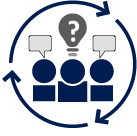Saxton Transportation Operations Laboratory Overview
 Shaping the future of transportation.
Shaping the future of transportation.

The Saxton Transportation Operations Laboratory (STOL) serves as a confluence of transportation research, development, testing, and deployment. Housed inside the Federal Highway Administration’s (FHWA) Turner-Fairbank Highway Research Center (TFHRC) in McLean, Virginia, the STOL enables the FHWA to conceptualize, validate, and refine innovative transportation services and technologies prior to larger scale development and implementation. The STOL is shaping the future of transportation systems management and operations (TSMO) by developing intelligent transportation solutions and advancing industry adoption.
The STOL is surrounded by extensive connected road, traffic signal, and mobile sensing networks that enable a broad range of research needs, including testing of connected automation applications. A fleet of vehicles for cooperative driving automation (CDA) research and development (R&D) is housed in the facility’s vehicle smart garage, and connected laboratories onsite host state-of-the-art simulation and analysis tools. Backed by a network of physical prototypes, test beds, and advanced simulation tools, the STOL enables the convergence of Federal staff, transportation researchers, academics, and industry collaborating on cutting-edge transportation research.
![]()
Our Mission
To research, develop, and evaluate cutting-edge transportation solutions that address today’s mobility challenges—paving the way for safer, smarter, and more efficient roadways.
Key Research Areas
• Vehicle-to-Everything Communications: Seamless data exchange between vehicles, infrastructure, and road users to improve safety and traffic flow.
• Cooperative Driving Automation: Integrating vehicle-to-everything communication with automation to optimize traffic flow, reduce congestion, and enhance mobility.
• Modeling, Evaluation, and Testing: Leveraging advanced simulations, digital twins, and real-world testing to validate connected and automated vehicle technologies.
• Workforce Development: Providing hands-on training, educational resources, and research collaborations to build a skilled transportation workforce.
• Open-Source Tools and Support: Developing datasets, simulation platforms, and technical resources to accelerate adoption and deployment.
Why the Saxton Laboratory Matters
• Real-World Testing: Our smart infrastructure and testbeds enable rigorous evaluation of emerging technologies.
• Collaborative Innovation: We bring together Government, academia, and industry to drive meaningful advancements.
• Practical Impact: Our research delivers actionable solutions to real-world transportation challenges.
• Shaping the Future: We contribute to developing standards that ensure interoperability across the transportation network.
![]()
Staff Expertise
The STOL also supports the workforce development and technology transfer of pioneering transportation service concepts and technologies through knowledgeable onsite staff operating support services programs, physical prototype systems, and advanced simulation capabilities.
Multimodal efforts of the USDOT generate groundbreaking research and pilot technologies through collaboration, research, and testing. Through this critical work, the STOL aims to enhance the Nation’s transportation system’s efficiency, safety, capacity, and reliability.

